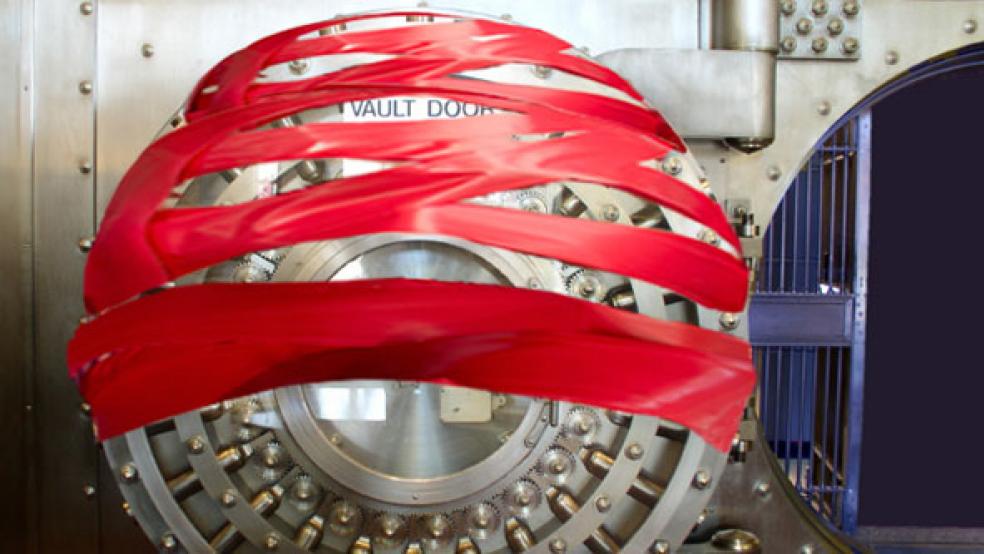Bank bashing remains a favorite sport. Just ask demonstrators in lower Manhattan or those in the corridors of Congress. Decrying the “gangsterism of Wall Street,” protestors in New York want to free the government from the monied influence of our tycoons. In less colorful fashion, our regulators and political leaders also want to shrink the importance of the financial sector.
Here’s the problem: While the animus is understandable, and even in some instances deserved, without a healthy and prosperous banking industry the economy cannot rebound.
Banks are under attack from a number of quarters. There’s Moody’s, which recently downgraded bankdebt; there’s former House Banking Committee Chairman Barney Frank, who hopes that the sands of history will erase his footprint from the financial crisis; and there’s Ben Bernanke, whose Operation Twist – a desperate attempt to buoy housing – will dumb down bank profit margins. There’s the attorneys general from across the nation who hope to follow in Andrew Cuomo’s political footsteps; the scores of regulators who refuse to admit that they were there, in the flesh and on the premises, with the tools necessary to stop the craziness; the faceless Basel III authors who are considered “anti-American” by JPMorgan Chase CEO Jamie Dimon; and President Obama, who hasn’t called out the Fat Cats of late except to invite them to campaign fundraisers.
Bank stocks have plunged since this past spring, with lawsuits and worries about Euro exposure grabbing headlines. Stocks move on future earnings, which look pretty dreadful right now; one sign of pessimism is low bank stock prices. More fundamentally, investors have begun to equate the financial sector with the dullest of utilities. In satisfying regulator demands for increased liquidity, higher capital ratios, and lower risk profiles, the banks have earned back their “safe haven” status. The proof is the flood of deposits pouring in. At the same time, lending – the goal of Fed policy – has stalled.
For over two years, Mr. Bernanke has been energetically tossing dollar bills into the great wind machine of the global monetary system. Nobody is more surprised than he, probably, to find that those dollars are floating right back to the Fed. While Fed reserves have soared more than $1.6 trillion since January 2008, bank loans have fallen $84 billion. The faltering economy has certainly reduced demand for money; but longtime bank analyst Richard Bove of Rochdale Securities claims the policies of the Obama administration are also to blame.
Mr. Bove says that the Fed’s quantitative easing policies, and the onerous requirements of Dodd-Frank, have constricted bank lending. In a recent report to clients, he points out that banks’ net interest margins peaked in the first quarter of 2010 and have been on the decline since. Under the newly announced Operation Twist, the yield curve will flatten, further wringing out bank profitability.
Possible damage to bank earnings was one of the concerns that led Dallas Federal Reserve Bank president Richard Fisher to vote against the program. Along with Mr. Fisher, Mr. Bove is skeptical of the plan’s success. Who, he asks, will make 30-year loans at historically low rates – below 4 percent today – when the latest CPI number was nearly 4 percent? There’s simply less incentive to lend long if you’re getting a lower price for it. As Mr. Obama might say, it is a matter of simple math. If you lower the price of something – even long-term credit – you’ll get less of it.
More problematic, Mr. Bove suggests that bringing down long-term versus short-term rates will encourage speculative short-lived bets over multiyear investment. He has a point.
Mr. Bove is not alone in thinking the Fed has it all wrong. Economist David Malpass (and budding GOP politician) describes Fed policy as “deeply contractionary,” and is among those looking for a recession. “The Fed is paying 25 basis points for excess reserves despite an effective Fed funds rate of 8 basis points,” Mr. Malpass points out in a recent note. Bankers may be unreliable, but they’re not stupid. Why put reserves at risk when you can earn a solid spread with the safest investment on the planet while satisfying ever more demanding regulators at the same time? Bank holdings of Treasury securities are up nearly fourfold since the fourth quarter of 2008.
Meanwhile, public perception about the banks was dealt another blow recently when Moody’s downgraded the debt of Bank of America, Citigroup, and Wells Fargo, which slammed investor confidence just as EU financial problems were again roiling markets. Moody’s rationale was that the government is “more likely now than during the financial crisis to allow a large bank to fail should it become financially troubled.” Rep. Frank, just to reassure voters that he is on their side, helpfully chimed in to applaud Moody’s insight “that such large institutions are not ‘too big to fail.’”
Really? Mr. Bove reminds us that Bank of America (to pick one) claims to have a relationship with 58 million businesses and households. That’s half the households in the U.S. Moreover, the company has $961 billion in loans outstanding and more than $1,038 billion in deposits. Since, on average, 79.3 percent of all U.S. bank deposits are insured by the FDIC, that agency would be on the hook for roughly $800 billion should Bank of America fail (an event Mr. Bove sees as extremely unlikely).
The FDIC at present has $3.9 billion in its insurance fund. Where would the balance come from? The FDIC would request the funds from Congress. Imagine the result: deadlock, finger pointing and all-out chaos.
One of the innovations of Dodd-Frank was its requirement that in the event a large bank failed, the FDIC could organize an orderly bankruptcy proceeding. There would be nothing orderly about half of American households panicking over the safety of their deposits, or their loans outstanding. Moreover, most bankers doubt the FDIC could handle such a monster management task.
Nobody has to hug a banker. But attempts to get our economy rolling down the track while reducing the steam in the boiler will fail. And continue to fail.






